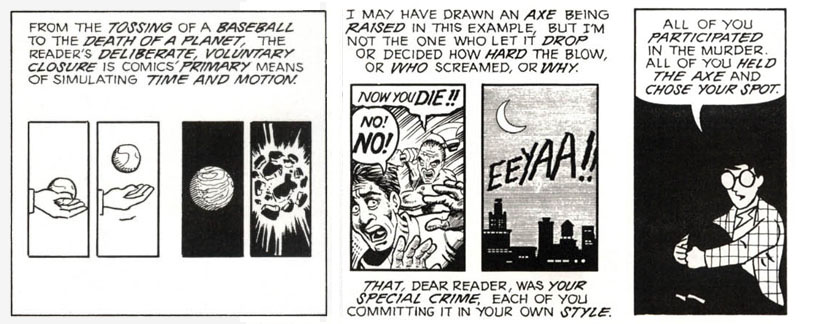A couple rules of thumb I use for crafting evocative scene descriptions as a GM:
THREE OF FIVE: Think about your five senses. Try to include three of them in each description. Sight is a gimme and a Taste will rarely apply, so that means picking a couple out of Hearing, Smell, and Touch. Remember that you don’t actually have to touch something in order to intuit what it might feel like if you did. Touch can also include things like wind and temperature.
TWO COOL DETAILS: Try to include two irrelevant-but-cool details. These are details that aren’t necessary for the encounter/room to function, but are still cool. It’s the broken cuckoo clock in the corner; the slightly noxious odor with no identifiable source; the graffiti scrawled on the wall; the bio-luminescent fungus; etc.
THREE-BY-THREE: Delta’s 1-2-(3)-Infinity talks about psychological research demonstrating that repeating something three times takes up the same space in our brains as repeating something infinitely. Thus, once you’ve hit the third item in a sequence, any additional items in that sequence are redundant.
Extrapolating from this, for minor scenes you can describe three things each with a single detail. At that point, you’ve filled up the “infinity queue” in your players’ brains and their imaginations, predicting the pattern, will impulsively fill in the finer details of the scene you’ve evoked. For “epic” descriptions, use the full three-by-three: Describe three different elements with three details each.
KEEP IT PITHY: On a similar note, lengthy descriptions are not how you achieve immersion. What you want are a handful of evocative images that the players can perform an act of closure upon to realize the scene in their own minds. This not only prevents them from “tuning out” a long description, the act of closure itself will draw them into and immerse them in the game world — they become, as Scott McCloud described under different circumstances in Understanding Comics, silent partners in the creation of the world, and thus become both invested in it and captured by it.
DESCRIPTION DOESN’T END: The legacy of boxed text indoctrinates a lot of GMs with the idea that you describe the environment up front and then, from that point forward, the players are just taking actions within the pre-established environment. But that’s an artificial dynamic. Instead, details of the setting can continue flowing through the description of that action: The crunch of broken glass beneath their feet as they move across the room. The coppery smell of blood as they draw near the corpse. The sudden chill from the wind whipping in through the shattered window.
Like most rules of thumb, of course, none of these should be treated like straitjackets.
This is an updated and expanded version of a tip that originally appeared in 2011.














Thank you for updating this. Coincidentally, I just stumbled across the original article a few days ago, thought it useful I bookmarked it for later reference. Now it’s even better!
Thanks!
I was also surprised to discover, when I went to update the link on the Gamemaster 101 page that the original post had never been properly indexed there. Makes me wonder what else is wandering lost through the archives here.
Oh my god, thank you for this post. This is a HUGE weakness of mine, and you’ve just given me something I thought impossible- a framework to mentally organize description. For someone like me, who remembers numbers and categories better than sensory details, this is super useful.
Never found the original, so this is as good as new content for me.
Thanks for this useful post!
May I only ask for some more rpg examples for “Three-by-Three” and “Keep It Pithy” points?
I despise long multi-paragraph boxed text that eventually got to the point there was a beholder in the middle of the room. If there’s a beholder in the middle of the room all descriptions should flow from that point and likely all deal with important things to jump behind.
I actually disagree with you, JDJarvis. (Not the overly elaborated boxed text part.)
While it’s true that the giant beholder in the middle of the room would be the first thing to capture the attention of the characters, what’s more important IMO is that (a) the giant beholder demands an immediate response and (b) from a practical standpoint, the players need to understand what their characters are seeing so that they can take actions within the proper context of the game world.
So if I do this: “THERE’S A BEHOLDER IN THE MIDDLE OF THE ROOM, description of room, description of room, description of room.” What I’ve done is delay the impetus of action.
But if I do this: “Description of room, description of room, description of room, but what immediately captures your attention is THE BEHOLDER IN THE MIDDLE OF THE ROOM.” I allow the players to share the “OH SHIT!” moment with their characters while also allowing them to immediately respond to that moment.
This is the same reason that I’ll have players roll initiative at the END of each combat and keep those rolls in my pocket for the next combat which starts. It allows me to jump from “THE GOBLINS AMBUSH YOU!” directly to “WHAT DO YOU DO?” instead of “THE GOBLINS AMBUSH YOU! … let’s spend the next 90 seconds rolling initiative scores and then you can actually respond to the surprise.”
@Justin. I agree with reversing the description stack to have the most important last because it adds a dramatic reveal into the flow of language that illuminates the scene and places the focus of the scene into the player’s minds lasts. So they tent to act on it first.
Another trick, I have used in the descriptions for locations, scenes, characters or the like. Is to hide an important piece of useful information mixed in the middle of description, if I don’t want the players to jump on it immediately. Then when it comes up a second time it will seem familiar to the players, and the observant ones will notice it. And if they don’t then your “rule of 3 clues” comes in to play to reinforce the point.
I did try this with “Two Cool Details” as a set of newspaper articles. The players decided that the random cool thing was a plot worth pursuing. While not advancing the Book-adventure, the characters did have fun with the side adventure.
Another thing in a similar vein to pre-rolling initiative, I use a perception pool. 5 results from the PCs, that I use in the background to make it easier to mixed more info into the descriptions I give the players (with acknowledgements of who noticed what)
This might be a Common Sense check but, in general, do you write down descriptions or do you make them on the spot using these guidelines?
@Sando: Yes.
Some descriptions get prepped. Others are improvised. I find these rules of thumb are handy to rattle around in the back of my mind either way.